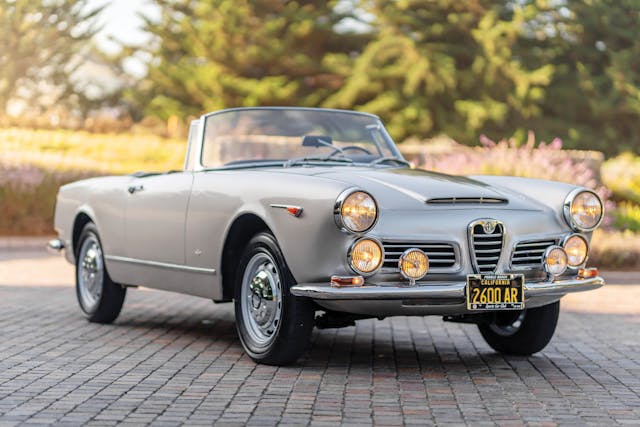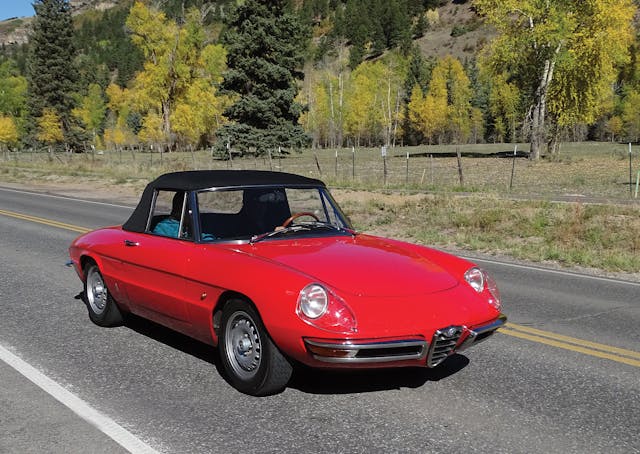Media | Articles
Alfa rose from WWII’s ashes to build decades of coveted cars
As Cole Porter might have put it: In the 1920s and 1930s, Alfa Romeo was The Top! Vittorio Jano was there, along with Gioacchino Colombo and Enzo Ferrari. Thanks to high-performance models such as the Zagato-bodied 6C 1750 GS, the 8C 2300 Le Mans, and the 8C 2900B—plus a host of world-class racing cars—Alfa Romeo was indisputably the grandest of Grand Marques, rivaled only by Bugatti.
World War II ruined all that. Completely controlled by Benito Mussolini’s government, Alfa’s factory in the Milan suburb of Portello was switched in 1940 from hand-crafting sports cars to assembling Daimler-Benz 34.0-liter V-12 aero engines under license. Flattened by Allied bombers in 1944, Alfa needed years to resume passenger-car production.
In the meantime, the automaker dominated early postwar grand prix racing with a prewar design. Two types of engines were eligible for Formula 1 in the post–World War II world: 4.5 liters normally aspirated or 1.5 liters supercharged. Designed in 1937, Gioacchino Colombo’s jewel-like 1.5-liter inline-eight could be supercharged to produce more than 420 horsepower, albeit while guzzling an explosive mixture of gasoline, methanol, and nitromethane.
In a competition career that stretched from 1938 to 1953, Alfa’s 158/159 Alfetta won a remarkable 47 grand prix races out of 54 entered, including back-to-back Formula 1 World Championships in 1950 and 1951 with aging prewar star Giuseppe “Nino” Farina and newcomer Juan Manuel Fangio. Today, only a few authentic Alfettas still exist, as well as two accurate replicas. If you’d like to buy one, the price for a genuine icon of racing history is going to be steep. Is $5 million too much? Maybe $10 million?

Though Alfa dominated Formula 1, it struggled with passenger cars. The 1946 Freccia d’Oro, derived from the prewar bread and butter 6C 2500, was a big, expensive Gran Turismo with coachbuilt bodywork; it was completely out of touch with economic conditions in war-ravaged Europe. Though few were sold, the 6C 2500 remained in Alfa catalogues until 1953. Today, 6C 2500 prices vary wildly, depending on condition, body style, and which coachbuilder built the body. Restoration projects start at less than $300,000; attractive, concours-winning convertibles can be worth more than $1 million.
Marketplace
Buy and sell classics with confidence
Alfa’s first postwar design was the 1900, which appeared in 1950 and stayed in production until 1958. Some 20,000 were built, about as many as all the prewar Alfas put together. A new 80-hp, 1.9-liter dual-over-head-cam inline-four used chains rather than gears to drive the camshafts, but otherwise it was very similar to Vittorio Jano–designed engines dating back to 1924. The new engine went into a factory-made unitized body/chassis sedan that looked like a bread box.
There was also an alternate sports-car chassis with a conventional ladder frame, independent front suspension, huge drum brakes, and Borrani knock-off wheels. The 1884-cc Sprint and 1975-cc Super Sprint were the last Alfas supplied in bulk to carrozzeria. Most of these smooth and desirable coupes and spiders received bodies by Bertone, Castagna, Pinin Farina, Touring, Vignale, or Zagato.
Today, you can buy a 1900 coupe with attractive, batch-built coupe bodywork by Touring or Pinin Farina for roughly $300,000, while a one-off, Zagato-bodied 1900 CSS Berlinetta with racing history, celebrity ownership, and concours restoration is going to cost you at least $1 million … or even double that.
The 1900 was a start, but what really saved Alfa Romeo was the smaller Giulietta/Giulia series, which debuted at the 1954 Turin Auto Show and stayed in production for an amazing four decades. The Giulietta/Giulia had a unitized body/chassis, front-engine configuration, rear-wheel drive, independent front suspension, a rigid rear axle with multi-links, and coil springs all around.
The new DOHC inline-four was built in 1290-cc, 1570-cc, 1779-cc, and 1962-cc versions and drove through either a four-speed or five-speed gearbox. There were the expected sedans and wagons, but, more important for our story, there were two new sports cars.
The Giulietta 1300 began with the adorable Carrozzeria Bertone Sprint coupe in 1954; the equally attractive Pinin Farina Spider came along in 1955. Both grew into the Giulia 1600 in 1962. The larger 2000 inline-four and 2600 inline-six engines were put into a similar but bigger chassis to create an exclusive Gran Turismo, but the 2000/2600 was both more expensive and less attractive—it also wasn’t as much fun.

The little Giulietta/Giulia Sprints and Spiders have risen precipitously in value; the best ones are approaching $250,000, though good ones can still be found for under $100,000. Compared with a Porsche 356, however, a Giulietta or Giulia seems like a bargain. These are delightful little cars—the very definition of an Italian sports car. They will always be in demand, and guaranteed to put a smile on your face.
From 1958 until 1967, Bertone built exactly 1366 coupes with either 1300 or 1600 engines on short-wheelbase Giulietta chassis. Styled by Franco Scaglione and called Sprint Speciale, the SS has always been controversial. People who love the SS consider it to be an exquisite jewel, while people who hate the SS think it’s the visual equivalent of chewing on tin foil. There is no middle ground! Back at the peak of the collector-car market in 2014, prices approached $500,000, but have since fallen precipitously. A mere $150,000 will now buy you a great Sprint Speciale.
At the 1960 Geneva Salon, Zagato presented a lightweight, street-legal Giulietta coupe by young styling sensation Ercole Spada. With aerodynamic aluminum bodywork and Plexiglass windows, 217 copies of the Sprint Zagato were completed by 1962. Using the SZ, Alfa Romeo won the 1.3-liter category in the FIA Grand Touring Manufacturers Championship in both 1962 and 1963. These exquisite little coupes are now priced from $500,000 to $750,000.

Back in the 1930s, Dr. Wunibald Kamm had theorized that a car with a vertical flat tail would generate turbulence that would act like the pointed tail of a teardrop to increase aerodynamic efficiency. In 1963, Alfa replaced the SZ with the TZ, also styled by Ercole Spada and incorporating a truncated “Kamm tail.” Only 112 TZs were completed in four years, with Giulia 1600 running gear and lightweight Zagato aluminum bodywork. A TZ weighed just 1460 pounds, ready to race. Nowadays, a TZ is worth twice as much as an SZ, anywhere from $1 million to $2 million.
A more radical Kamm tail graced the 1965 TZ2. This used a fiberglass body instead of the TZ’s aluminum, which not only improved aerodynamics but got the weight down to 1370 pounds. With 175 horsepower from a Conrero-tuned, 1570-cc Giulia engine, a TZ2 could easily top 150 mph. Only 12 TZ2s were built, and it will now take roughly $3 million to park one in your garage.
Nowhere near as rare but just as collectible is the 1963 Alfa Romeo Sprint GT, designed by a very young Giorgetto Giugiaro for Bertone. Over the next 14 years, the GT was powered by every size of Giulietta/Giulia engine, turned into a variety of racing models, renamed Gran Turismo Veloce, and became a classic in its own right. The GTV has proved to be timeless and evergreen, one of the most beloved Alfa Romeos of all.

GTVs from the 1960s and 1970s are now in the $50,000 to $100,000 range for a good one, less than half the price of a Porsche 911 with which these Alfas originally competed. GTA and GT Trans-Am racers are going for astronomical amounts, but still significantly less than a Porsche 911 Carrera RS or RSR.
In 1966, the GTV was joined by an equally popular new spider designed by Franco Martinengo for Pininfarina. For the first four years, the spider had a distinctive rounded boat tail. This highly desirable model is now often called the Duetto and was made famous in the 1967 film The Graduate. Just 9000 were made. Prices are now in the $30,000 to $50,000 range, surprisingly less than the mechanically similar GTV.

In 1970, the spider was given a flat tail sort of like that on the TZ coupe. The timeless model soldiered on until 1993, just two years before new owner Fiat pulled Alfa out of the U.S. market. By then, Alfa had sold 110,000 Kamm tails. Run-of-the-mill Alfa spiders from the 1980s and 1990s can still be found for less than $10,000, and even concours winners are going for less than $50,000.
There is one postwar Alfa Romeo sports car that was never sold in the U.S. when new but has still become a significant collectible. At the 1967 Montreal Expo, Alfa exhibited a concept car with body by Marcello Gandini of Bertone on a Giulia Sprint GT chassis. This was put into limited production with a 2.6-liter V-8 derived from the Alfa Tipo 33 sports/racer.
Alfa built just 3700 Montreal coupes in six years, priced even higher than a Jaguar E-Type or Porsche 911. Thanks primarily to high maintenance and restoration costs, these rare machines are surprisingly inexpensive, averaging around $60,000 over the past five years, and less than $100,000 for the best of the best.

In 1986, Alfa Romeo was taken over by Fiat, becoming part of Gianni Agnelli’s “ladder of marques” that climbed in price and prestige: Fiat, Alfa Romeo, Lancia, Maserati, Ferrari. In 1989, Alfa stylist Antonio Castellana and Fiat stylist Robert Opron collaborated to design a limited-production sports car confusingly named SZ, like the totally different model from three decades earlier. The new SZ was based on the Alfa Romeo Milano 75 sedan that had finally replaced the Giulietta.
For the SZ, the Milano chassis was modified with a racing suspension; Koni shock absorbers; wide wheels wearing Pirelli P Zero tires; a 210-hp 2959-cc V-6; and a five-speed manual gearbox. Zagato built the SZ coupe and RZ convertible with unique injection-molded thermoplastic body panels. A total of 284 SZ and RZ models were completed over a period of five years. One of these Alfa SZs from the early 1990s will cost you between $40,000 and $100,000 depending on condition, but now that they are more than 25 years old and can be imported into the United States, prices are rising rapidly.
Every Alfa Romeo sports car ever built is being collected somewhere by a fanatical Alfisti. There’s a reason. Alfa Romeo embodies the timelessly iconic Italian sports car mystique: exciting, high-performance machines that are technically interesting, artistically beautiful, and fun to drive.
Postwar Alfa Romeos is one of 20 classes to be featured at the 2023 Greenwich Concours d’Elegance, on June 2-4, 2023. Download the 2023 Greenwich Concours d’Elegance event program to learn more about Sunday’s other featured classes, Saturday’s Concours de Sport, our judges, sponsors, non-profit partners, 2022 winners and more!
***
Check out the Hagerty Media homepage so you don’t miss a single story, or better yet, bookmark it. To get our best stories delivered right to your inbox, subscribe to our newsletters.






















